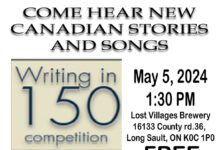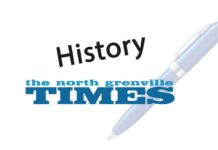Life in the Wolford area in 1818 was not as primitive as one might think. There were three mills for grinding grain, four mills for sawing timber, and one for carding wool. The price for grinding grain was one-twelfth of the grain; for sawing timber, 2S. 6d. per 100 feet, or half the timber; and for carding wool, 5d. per lb. A horse sold for £15, a cow for £5, an ox, £8, and a sheep, 7s. 6d., if bought after shearing; if not, the price varied.
Robert Gourlay, in his final report, ““Statistical Account of Upper Canada”, gave some average prices for the basic needs of life as he found them across the province.
“A good frame farm house costs from £125 to £50; a good frame barn, £125. A log house, £25.”
Using the services of a blacksmith working iron was at the rate of 7½d. per lb. “common work”, whereas making chains cost just 1 shilling. An axe cost 12s. 6d.; a hoe, 5s.; shoeing a horse cost 10s.
Other trades and professions charged varying amounts for their talents. Carding wool was charged at the rate of 7½d. per lb., while a tailor charged, for making a coat, from 20s. to 27s. 6d.; and I0s. for pantaloons. Shoemakers charged 3s. 9d. for making a pair of shoes; and a weaver, for weaving a yard of common flannel, earned between one shilling and 1s 6d.
There was a strong ambition within these communities to see growth and an improvement in living conditions. Robert Gourlay was possibly the first outsider to actually seek the input of local settlers in the townships of Upper Canada in his survey. Most refused to cooperate with him, largely because of the opposition Gourlay faced from the governing elite and Bishop Strachan. Wolford was one of the few to respond to his invitation, and, in fact, they sent him a later submission which they said they had decided upon “After a more serious consideration of query, number 30th.” It had asked about the: “state of public roads, and if capable of much improvement at a moderate expence; also, if any water conveyance; or, if this could be obtained, extended, or improved, by means of canals, locks, etc., etc.”.
On January 26, 1818, three of the Burritts, Stephen, Daniel, and Henry, along with William Merrick, wrote to Gourlay to give their views on the subject. What they had to say presaged the direction the Imperial Government in London would take in the following decades, the building of the Rideau Canal.
“The water communication of the river Rideau is capable of great improvement by canalling, which may be done at small expence, for boats of three tons, as most of the materials may be obtained on the spot.”
To this answer to Question 30, they added some thoughts on Question 31, which was a rather daring thing to do for these local settlers. Question 31 was considered the most controversial of all, and was considered by the ruling elite to be the most dangerous, even revolutionary, of them all. At first sight, it may seem innocuous: “What, in your opinion, retards the improvement of your Township in particular, or the province in general; and what would most contribute to the same?”
Inevitably, this was seen as a direct criticism of the way the province had been governed, and invited the settlers to comment and have a say in their future as a community. This, it was alleged, was mob democracy, and a threat to the ruling order of things.
However, the answer that the Burritts and Merrick gave was quite reasonable and held no particularly political overtones. They merely pointed out that the land granting system needed revising in the light of government decisions following the War of 1812, when the immigration of new settlers from the United States had been, in theory at least, prohibited. Before that, it seemed that American land speculators had been busy in the area, buying up land and then selling it for a high price, one beyond the reach of many potential settlers. They further repeated the potential of the area once the Rideau could be made navigable.
“On the first settlement of this province, or shortly after the disturbance in Europe commenced, and no emigration took place from that country, the government of this province made proclamation for settlers from the United States: a number applied and obtained such titles as the government were at that time giving, and sold them, and returned to the states; and the purchasers have obtained titles of the same, and hold their lands at so high a price that the poor are not able to purchase. This is the reason that we have to offer, and what impedes the settlement of this province, or this place.
From the mouth of the river Rideau to Perth, on the Tay, is a distance of about 70 miles, and a small part a good settlement, and the other part land good for settling, and the river affords anumber of excellent mill seats.”
Robert Gourlay did not spend a long time in Upper Canada, but his effect on the country, both then and since, has been marked. Thanks to his efforts, we have this detailed picture of the Wolford area in 1818, just twenty years after the township had been surveyed. Bishop Strachan may not have approved of Gourlay, but those of us who came later can be grateful that he dropped by.






